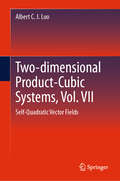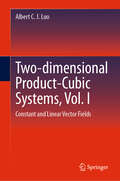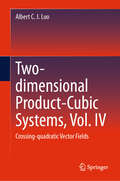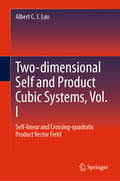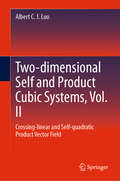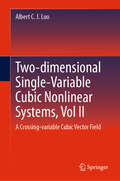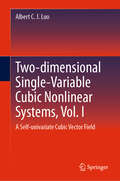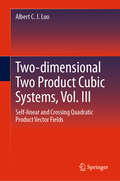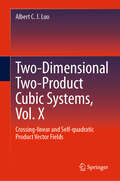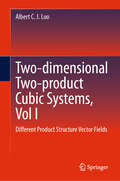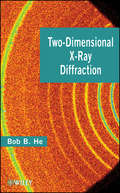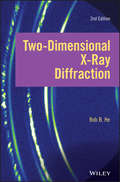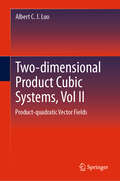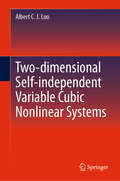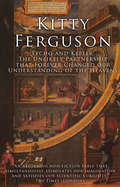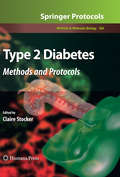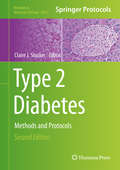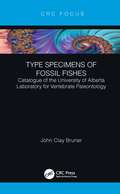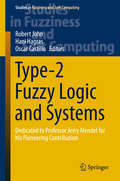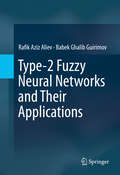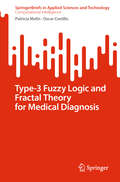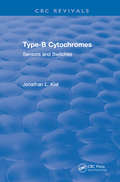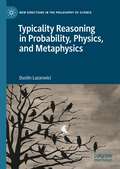- Table View
- List View
Two-dimensional Product Cubic Systems, Vol. VII: Self- Quadratic Vector Fields
by Albert C. LuoThis book is the seventh of 15 related monographs, concerns nonlinear dynamics and singularity of cubic dynamical systems possessing a product-cubic vector field and a self-univariate quadratic vector field. The equilibrium singularity and bifurcation dynamics are discussed. The saddle-source (sink) is the appearing bifurcations for saddle and source (sink). The double-saddle equilibriums are the appearing bifurcations of the saddle-source and saddle-sink, and also the appearing bifurcations of the network of saddles, sink and source. The infinite-equilibriums for the switching bifurcations include: • inflection-saddle infinite-equilibriums, • hyperbolic-source (sink) infinite-equilibriums, • up-down (down-up) saddle infinite-equilibriums, • inflection-source (sink) infinite-equilibriums.
Two-dimensional Product-Cubic Systems, Vol. I: Constant and Linear Vector Fields
by Albert C. LuoThis book, the fifth of 15 related monographs, presents systematically a theory of product-cubic nonlinear systems with constant and single-variable linear vector fields. The product-cubic vector field is a product of linear and quadratic different univariate functions. The hyperbolic and hyperbolic-secant flows with directrix flows in the cubic product system with a constant vector field are discussed first, and the cubic product systems with self-linear and crossing-linear vector fields are discussed. The inflection-source (sink) infinite equilibriums are presented for the switching bifurcations of a connected hyperbolic flow and saddle with hyperbolic-secant flow and source (sink) for the connected the separated hyperbolic and hyperbolic-secant flows. The inflection-sink and source infinite-equilibriums with parabola-saddles are presented for the switching bifurcations of a separated hyperbolic flow and saddle with a hyperbolic-secant flow and center. Readers learn new concepts, theory, phenomena, and analysis techniques, such as Constant and product-cubic systems, Linear-univariate and product-cubic systems, Hyperbolic and hyperbolic-secant flows, Connected hyperbolic and hyperbolic-secant flows, Separated hyperbolic and hyperbolic-secant flows, Inflection-source (sink) Infinite-equilibriums and Infinite-equilibrium switching bifurcations.
Two-dimensional Product-Cubic Systems, Vol. IV: Crossing-quadratic Vector Fields
by Albert C. LuoThis book, the eighth of 15 related monographs, discusses a product-cubic dynamical system possessing a product-cubic vector field and a crossing-univariate quadratic vector field. It presents equilibrium singularity and bifurcation dynamics, and . the saddle-source (sink) examined is the appearing bifurcations for saddle and source (sink). The double-inflection saddle equilibriums are the appearing bifurcations of the saddle and center, and also the appearing bifurcations of the network of saddles and centers. The infinite-equilibriums for the switching bifurcations featured in this volume include: Parabola-source (sink) infinite-equilibriums, Inflection-source (sink) infinite-equilibriums, Hyperbolic (circular) sink-to source infinite-equilibriums, Hyperbolic (circular) lower-to-upper saddle infinite-equilibriums.
Two-dimensional Self and Product Cubic Systems, Vol. I: Self-linear and Crossing-quadratic Product Vector Field
by Albert C. LuoThis book, the 14th of 15 related monographs on Cubic Dynamical Systems, discusses crossing and product cubic systems with a self-linear and crossing-quadratic product vector field. Dr. Luo discusses singular equilibrium series with inflection-source (sink) flows that are switched with parabola-source (sink) infinite-equilibriums. He further describes networks of simple equilibriums with connected hyperbolic flows are obtained, which are switched with inflection-source (sink) and parabola-saddle infinite-equilibriums, and nonlinear dynamics and singularity for such crossing and product cubic systems. In such cubic systems, the appearing bifurcations are: double-inflection saddles, inflection-source (sink) flows, parabola-saddles (saddle-center), third-order parabola-saddles, third-order saddles (centers), third-order saddle-source (sink).
Two-dimensional Self and Product Cubic Systems, Vol. II: Crossing-linear and Self-quadratic Product Vector Field
by Albert C. LuoThis book is the thirteenth of 15 related monographs on Cubic Dynamical Systems, discusses self- and product-cubic systems with a crossing-linear and self-quadratic products vector field. Equilibrium series with flow singularity are presented and the corresponding switching bifurcations are discussed through up-down saddles, third-order concave-source (sink), and up-down-to-down-up saddles infinite-equilibriums. The author discusses how equilibrium networks with paralleled hyperbolic and hyperbolic-secant flows exist in such cubic systems, and the corresponding switching bifurcations obtained through the inflection-source and sink infinite-equilibriums. In such cubic systems, the appearing bifurcations are: saddle-source (sink) hyperbolic-to-hyperbolic-secant flows double-saddle third-order saddle, sink and source third-order saddle-source (sink)
Two-dimensional Single-Variable Cubic Nonlinear Systems, Vol II: A Crossing-variable Cubic Vector Field
by Albert C. LuoThis book, the second of 15 related monographs, presents systematically a theory of cubic nonlinear systems with single-variable vector fields. The cubic vector fields are of crossing-variables, which are discussed as the second part. The 1-dimensional flow singularity and bifurcations are discussed in such cubic systems. The appearing and switching bifurcations of the 1-dimensional flows in such 2-diemnsional cubic systems are for the first time to be presented. Third-order parabola flows are presented, and the upper and lower saddle flows are also presented. The infinite-equilibriums are the switching bifurcations for the first and third-order parabola flows, and inflection flows with the first source and sink flows, and the upper and lower-saddle flows. The appearing bifurcations in such cubic systems includes inflection flows and third-order parabola flows, upper and lower-saddle flows. Readers will learn new concepts, theory, phenomena, and analytic techniques, including Constant and crossing-cubic systems Crossing-linear and crossing-cubic systems Crossing-quadratic and crossing-cubic systems Crossing-cubic and crossing-cubic systems Appearing and switching bifurcations Third-order centers and saddles Parabola-saddles and inflection-saddles Homoclinic-orbit network with centers Appearing bifurcations
Two-dimensional Single-Variable Cubic Nonlinear Systems, Vol. I: A Self-univariate Cubic Vector Field
by Albert C. LuoThis book is the first of 15 related monographs, presents systematically a theory of cubic nonlinear systems with single-variable vector fields. The cubic vector fields are of self-variables and are discussed as the first part of the book. The 1-dimensional flow singularity and bifurcations are discussed in such cubic systems. The appearing and switching bifurcations of the 1-dimensional flows in such 2-dimensional cubic systems are for the first time to be presented. Third-order source and sink flows are presented, and the third-order parabola flows are also presented. The infinite-equilibriums are the switching bifurcations for the first and third-order source and sink flows, and the second-order saddle flows with the first and third-order parabola flows, and the inflection flows. The appearing bifurcations in such cubic systems includes saddle flows and third-order source (sink) flows, inflection flows and third-order up (down)-parabola flows.
Two-dimensional Two Product Cubic Systems, Vol. III: Self-linear and Crossing Quadratic Product Vector Fields
by Albert C. LuoThis book is the eleventh of 15 related monographs on Cubic Systems, examines self-linear and crossing-quadratic product systems. It discusses the equilibrium and flow singularity and bifurcations, The double-inflection saddles featured in this volume are the appearing bifurcations for two connected parabola-saddles, and also for saddles and centers. The parabola saddles are for the appearing bifurcations of saddle and center. The inflection-source and sink flows are the appearing bifurcations for connected hyperbolic and hyperbolic-secant flows. Networks of higher-order equilibriums and flows are presented. For the network switching, the inflection-sink and source infinite-equilibriums exist, and parabola-source and sink infinite-equilibriums are obtained. The equilibrium networks with connected hyperbolic and hyperbolic-secant flows are discussed. The inflection-source and sink infinite-equilibriums are for the switching bifurcation of two equilibrium networks.
Two-dimensional Two-product Cubic Systems Vol. X: Crossing-linear and Self-quadratic Product Vector Fields
by Albert C. LuoThis book is the tenth of 15 related monographs, discusses product-cubic nonlinear systems with two crossing-linear and self-quadratic products vector fields and the dynamic behaviors and singularity are presented through the first integral manifolds. The equilibrium and flow singularity and bifurcations discussed in this volume are for the appearing and switching bifurcations. The double-saddle equilibriums described are the appearing bifurcations for saddle source and saddle-sink, and for a network of saddles, sink and source. The infinite-equilibriums for the switching bifurcations are also presented, specifically: · Inflection-saddle infinite-equilibriums, · Hyperbolic (hyperbolic-secant)-sink and source infinite-equilibriums · Up-down and down-up saddle infinite-equilibriums, · Inflection-source (sink) infinite-equilibriums.
Two-dimensional Two-product Cubic Systems, Vol I: Different Product Structure Vector Fields
by Albert C. LuoThis book is the ninth of 15 related monographs, discusses a two product-cubic dynamical system possessing different product-cubic structures and the equilibrium and flow singularity and bifurcations for appearing and switching bifurcations. The appearing bifurcations herein are parabola-saddles, saddle-sources (sinks), hyperbolic-to-hyperbolic-secant flows, and inflection-source (sink) flows. The switching bifurcations for saddle-source (sink) with hyperbolic-to-hyperbolic-secant flows and parabola-saddles with inflection-source (sink) flows are based on the parabola-source (sink), parabola-saddles, inflection-saddles infinite-equilibriums. The switching bifurcations for the network of the simple equilibriums with hyperbolic flows are parabola-saddles and inflection-source (sink) on the inflection-source and sink infinite-equilibriums. Readers will learn new concepts, theory, phenomena, and analysis techniques. · Two-different product-cubic systems · Hybrid networks of higher-order equilibriums and flows · Hybrid series of simple equilibriums and hyperbolic flows · Higher-singular equilibrium appearing bifurcations · Higher-order singular flow appearing bifurcations · Parabola-source (sink) infinite-equilibriums · Parabola-saddle infinite-equilibriums · Inflection-saddle infinite-equilibriums · Inflection-source (sink) infinite-equilibriums · Infinite-equilibrium switching bifurcations.
Two-dimensional X-Ray Diffraction
by B. B. HeWritten by one of the pioneers of 2D X-Ray Diffraction, this useful guide covers the fundamentals, experimental methods and applications of two-dimensional x-ray diffraction, including geometry convention, x-ray source and optics, two-dimensional detectors, diffraction data interpretation, and configurations for various applications, such as phase identification, texture, stress, microstructure analysis, crystallinity, thin film analysis and combinatorial screening. Experimental examples in materials research, pharmaceuticals, and forensics are also given. This presents a key resource to researchers in materials science, chemistry, physics, and pharmaceuticals, as well as graduate-level students in these areas.
Two-dimensional X-ray Diffraction
by Bob B. HeAn indispensable resource for researchers and students in materials science, chemistry, physics, and pharmaceuticals Written by one of the pioneers of 2D X-Ray Diffraction, this updated and expanded edition of the definitive text in the field provides comprehensive coverage of the fundamentals of that analytical method, as well as state-of-the art experimental methods and applications. Geometry convention, x-ray source and optics, two-dimensional detectors, diffraction data interpretation, and configurations for various applications, such as phase identification, texture, stress, microstructure analysis, crystallinity, thin film analysis, and combinatorial screening are all covered in detail. Numerous experimental examples in materials research, manufacture, and pharmaceuticals are provided throughout. Two-dimensional x-ray diffraction is the ideal, non-destructive analytical method for examining samples of all kinds including metals, polymers, ceramics, semiconductors, thin films, coatings, paints, biomaterials, composites, and more. Two-Dimensional X-Ray Diffraction, Second Edition is an up-to-date resource for understanding how the latest 2D detectors are integrated into diffractometers, how to get the best data using the 2D detector for diffraction, and how to interpret this data. All those desirous of setting up a 2D diffraction in their own laboratories will find the author’s coverage of the physical principles, projection geometry, and mathematical derivations extremely helpful. Features new contents in all chapters with most figures in full color to reveal more details in illustrations and diffraction patterns Covers the recent advances in detector technology and 2D data collection strategies that have led to dramatic increases in the use of two-dimensional detectors for x-ray diffraction Provides in-depth coverage of new innovations in x-ray sources, optics, system configurations, applications and data evaluation algorithms Contains new methods and experimental examples in stress, texture, crystal size, crystal orientation and thin film analysis Two-Dimensional X-Ray Diffraction, Second Edition is an important working resource for industrial and academic researchers and developers in materials science, chemistry, physics, pharmaceuticals, and all those who use x-ray diffraction as a characterization method. Users of all levels, instrument technicians and X-ray laboratory managers, as well as instrument developers, will want to have it on hand.
Two-dimensional Product-cubic Systems, Vol.II: Product-quadratic Vector Fields
by Albert C. LuoThis book, the sixth of 15 related monographs, discusses singularity and networks of equilibriums and 1-diemsnional flows in product quadratic and cubic systems. The author explains how, in the networks, equilibriums have source, sink and saddles with counter-clockwise and clockwise centers and positive and negative saddles, and the 1-dimensional flows includes source and sink flows, parabola flows with hyperbolic and hyperbolic-secant flows. He further describes how the singular equilibriums are saddle-source (sink) and parabola-saddles for the appearing bifurcations, and the 1-dimensional singular flows are the hyperbolic-to-hyperbolic-secant flows and inflection source (sink) flows for 1-dimensional flow appearing bifurcations, and the switching bifurcations are based on the infinite-equilibriums, including inflection-source (sink), parabola-source (sink), up-down and down-up upper-saddle (lower-saddle), up-down (down-up) sink-to-source and source-to-sink, hyperbolic and hyperbolic-secant saddles. The diagonal-inflection upper-saddle and lower-saddle infinite-equilibriums are for the double switching bifurcations. The networks of hyperbolic flows with connected saddle, source and center are presented, and the networks of the hyperbolic flows with paralleled saddle and center are also illustrated. Readers will learn new concepts, theory, phenomena, and analysis techniques. Product-quadratic and product cubic systems Self-linear and crossing-quadratic product vector fields Self-quadratic and crossing-linear product vector fields Hybrid networks of equilibriums and 1-dimensional flows Up-down and down-up saddle infinite-equilibriums Up-down and down-up sink-to-source infinite-equilibriums Inflection-source (sink) Infinite-equilibriums Diagonal inflection saddle infinite-equilibriums Infinite-equilibrium switching bifurcations
Two-dimensional Self-independent Variable Cubic Nonlinear Systems
by Albert C. LuoThis book, the third of 15 related monographs, presents systematically a theory of self-independent cubic nonlinear systems. Here, at least one vector field is self-cubic, and the other vector field can be constant, self-linear, self-quadratic, or self-cubic. For constant vector fields in this book, the dynamical systems possess 1-dimensional flows, such as source, sink and saddle flows, plus third-order source and sink flows. For self-linear and self-cubic systems discussed, the dynamical systems possess source, sink and saddle equilibriums, saddle-source and saddle-sink, third-order sink and source (i.e, (3rd SI:SI)-sink and (3rdSO:SO)-source) and third-order source (i.e., (3rd SO:SI)-saddle, (3rd SI, SO)-saddle) . For self-quadratic and self-cubic systems, in addition to the first and third-order sink, source and saddles plus saddle-source and saddle-sink, there are (3:2)-saddle-sink and (3:2) saddle-source and double-saddles. For the two self-cubic systems, (3:3)-source, sink and saddles exist. Finally, the author describes that homoclinic orbits without centers can be formed, and the corresponding homoclinic networks of source, sink and saddles exists. Readers will learn new concepts, theory, phenomena, and analytic techniques, including Constant and crossing-cubic systems Crossing-linear and crossing-cubic systems Crossing-quadratic and crossing-cubic systems Crossing-cubic and crossing-cubic systems Appearing and switching bifurcations Third-order centers and saddles Parabola-saddles and inflection-saddles Homoclinic-orbit network with centers Appearing bifurcations
Tycho and Kepler: The Unlikely Partnership that Forever Changed our Understanding of the Heavens
by Kitty FergusonThe extraordinary, unlikely tale of Tycho Brahe and Johannes Kepler and their enormous contribution to astronomy and understanding of the cosmos is one of the strangest stories in the history of science.Kepler was a poor, devoutly religious teacher with a genius for mathematics. Brahe was an arrogant, extravagant aristocrat who possessed the finest astronomical instruments and observations of the time, before the telescope. Both espoused theories that seem off-the-wall to modern minds, but their fateful meeting in Prague in 1600 was to change the future of science.Set in one of the most turbulent and colourful eras in European history, when medieval was giving way to modern, Tycho and Kepler is a double biography of these two remarkable men.
Tyler's Herbs of Choice: The Therapeutic Use of Phytomedicinals, Third Edition
by Dennis V.C. AwangDoes Echinacea fight the common cold? Does St. John's Wort (SJW) really counteract depression? What about chondroitin for joint health? Today's healthcare professionals are increasingly confronted with questions from patients who want to use herbal supplements to treat various conditions. A critical and scientific assessment of medicinal plant rese
Tyler's Honest Herbal: A Sensible Guide to the Use of Herbs and Related Remedies
by Steven FosterHere is the fourth edition of Tyler's Honest Herbal: A Sensible Guide to the Use of Herbs and Related Remedies, providing essential botanical information as well as folkloric background of herbal remedies in a clear, accessible style. Unlike other herb books, this book gives you a serious evaluation of both the positive and negative features of the
Type 2 Diabetes
by Claire StockerDiabetes is now reaching epidemic proportions, and the associated complications of this disease can be disabling and even life-threatening. In Type 2 Diabetes: Methods and Protocols, leading investigators provide up-to-date explanations of commonly used laboratory protocols used in diabetes research. Covering the commonly described in vivo and in vitro model systems, the volume ultimately leads to an overall view of how cellular dysfunction and degeneration leads to susceptibility and diabetes disease progression. Written in the highly successful Methods in Molecular BiologyTM series format, chapters include brief introductions to their respective subjects, lists of the necessary materials and reagents, step-by-step, readily reproducible protocols, and expert notes on troubleshooting and avoiding known pitfalls. Comprehensive and cutting-edge, Type 2 Diabetes: Methods and Protocols offers succinct, proven techniques to aid research scientists and clinicians in continuing the study of this debilitating disease.
Type 2 Diabetes: Methods and Protocols (Methods in Molecular Biology #2076)
by Claire J. StockerThis second edition volume expands on the previous editions with updates on the commonly used techniques and analysis used by clinicians and scientists to study diabetes. The chapters in this book cover topics such as nutritional models of type 2 diabetes mellitus; the isolation and purification of rodent pancreatic islets of Langerhans; nitric oxide and redox state measurements in pancreatic beta cells; and primary adipocytes as a model for insulin sensitivity. Written in the highly successful Methods in Molecular Biology series format, chapters include introductions to their respective topics, lists of the necessary materials and reagents, step-by-step, readily reproducible laboratory protocols, and tips on troubleshooting and avoiding known pitfalls.Cutting-edge and practical, Type 2 Diabetes: Methods and Protocols, Second Edition is a valuable resource for all researchers who are interested in learning more about this important and evolving field.
Type Specimens of Fossil Fishes: Catalogue of the University of Alberta Laboratory for Vertebrate Paleontology
by John Clay BrunerThe Laboratory for Vertebrate Paleontology at the University of Allberta houses type specimens of fossil fishes. This book is a catalogue of these specimens. Included for each entry is taxonomy, detailed collection locality information, the citation wherein the species was originally described, and a list of individual type specimens. This is the first list ever compiled of the fossil fish types deposited in the collections of the University of Alberta Laboratory for Vertebrate Paleontology (UALVP). This collection contains 88 fish holotypes, 966 fish paratypes, 55 casts of fish holotypes from other museums, and 20 casts of fish paratypes from other museums. Key selling features: List all of the type specimens of fossil fishes currently housed in the collection of the Laboratory of Vertebrate Paleontology at the University of Alberta in Edmonton, Canada. Provides details of all 88 holotypes and nearly 1000 paratypes as well as casts of types specimens held in other museum collections. Includes information on unpublished "types" - type specimens of not yet described new species.
Type-2 Fuzzy Logic and Systems: Dedicated to Professor Jerry Mendel for his Pioneering Contribution (Studies in Fuzziness and Soft Computing #362)
by Oscar Castillo Hani Hagras Robert JohnThis book explores recent perspectives on type-2 fuzzy sets. Written as a tribute to Professor Jerry Mendel for his pioneering works on type-2 fuzzy sets and systems, it covers a wide range of topics, including applications to the Go game, machine learning and pattern recognition, as well as type-2 fuzzy control and intelligent systems. The book is intended as a reference guide for the type-2 fuzzy logic community, yet it aims also at other communities dealing with similar methods and applications.
Type-2 Fuzzy Neural Networks and Their Applications
by Rafik Aziz Aliev Babek Ghalib GuirimovThis book deals with the theory, design principles, and application of hybrid intelligent systems using type-2 fuzzy sets in combination with other paradigms of Soft Computing technology such as Neuro-Computing and Evolutionary Computing. It provides a self-contained exposition of the foundation of type-2 fuzzy neural networks and presents a vast compendium of its applications to control, forecasting, decision making, system identification and other real problems. Type-2 Fuzzy Neural Networks and Their Applications is helpful for teachers and students of universities and colleges, for scientists and practitioners from various fields such as control, decision analysis, pattern recognition and similar fields.
Type-3 Fuzzy Logic and Fractal Theory for Medical Diagnosis (SpringerBriefs in Applied Sciences and Technology)
by Oscar Castillo Patricia MelinThis book is intended to be a reference for scientists and engineers interested in applying type-3 fuzzy logic and fractal theory techniques in medical diagnosis. In this book, a new model based on type-3 fuzzy logic and fractal theory for applications in medical diagnosis is presented. The main idea is that a higher type and order of fuzzy logic can help in solving various diagnosis problems and find better results. In addition, fractal theory is also employed for enhancing medical diagnosis. In this regard, several hybrid intelligent methods are offered. In this book, the authors test the proposed methods using several medical diagnosis problems, like diagnosis of problems in the brain, hearth, lungs, and others. The authors can notice that when type-3 fuzzy systems are implemented to model the behavior of systems, the results in diagnosis are enhanced, because the management of uncertainty is better. For this reason, the authors consider in this book the proposed methods using type-3 fuzzy systems and fractal theory to improve the diagnosis in complex medical problems.
Type-B Cytochromes: Sensors and Switches
by J.L. KielThis book describes cellular level sensors that act as switches, turning on gene expression and other metabolic processes necessary for cell survival and differentiation. These responses can also initiate programmed cell death or activate latent human immunodeficiency virus or animal leukemia viruses. These redox sensors are nonspecific in sensitivity but specific in response. Unlike ligand/antiligand-type specific sensors, they respond to ionizing and ultraviolet radiations, pH gradients, heat, light, electric and magnetic fields, redox chemicals, mechanical stress, and other nonspecific stressors. The sensors are type-b cytochromes, including NADPH oxidases, NO synthases, and nitrogen oxide reductases. The intense radiation of early pre-biotic earth may have been the evolutionary driving force for the development of their common ancestor.
Typicality Reasoning in Probability, Physics, and Metaphysics (New Directions in the Philosophy of Science)
by Dustin LazaroviciThis book provides a comprehensive investigation into the concept of typicality and its significance for physics and the philosophy of science. It identifies typicality as a fundamental way of reasoning, central to how natural laws explain and are tested against phenomena. The book discusses various applications of typicality to foundational questions in physics and beyond.These include:a unified interpretation of objective probabilities in classical mechanics and quantum mechanicsa detailed discussion of Boltzmann's statistical mechanics, entropy, and the second law of thermodynamicsa novel account of the asymmetry of causation and the arrow of time Finally, the book turns to the question: "What are laws of nature"? It argues that typicality extends to a powerful way of reasoning in metaphysics that can and should inform our commitments about the fundamental ontology of the world. On this basis, it develops an argument against the Humean best system account, according to which laws of nature are merely an efficient summary of contingent regularities.
